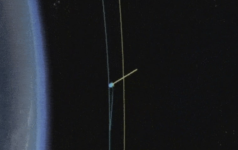There is a re-examination of space tethers and skyhooks to find near terms use cases. Harsimony at Greaterwrong.com provides the analysis of value for tethers

www.nextbigfuture.com
High Volume SpaceX Starship flights Can use Space Tether to Save Fuel
 There is a re-examination of space tethers and skyhooks to find near terms use cases.
There is a re-examination of space tethers and skyhooks to find near terms use cases. Harsimony at Greaterwrong.com provides the analysis of value for tethers when we have a lot of space launches and space activity.
A tether that spins at 1.74 km/s is ideal for some boosting to the moon. The fuel cost per launch is 293 tonnes, less than half the 713 tonnes we needed originally. The required size of a tether spinning at this speed is 1310 tonnes, which should take roughly 10 launches to build.
Boosting all the way to Mars for a dV of 9.31 km/s. In this case the ideal tether spins at 2.19 km/s and has a mass of 2560 tonnes. Now, the trip requires 813 tonnes of fuel versus 2230 tonnes without a tether.

You need to get more uses out of the tether and counter weight system to get more fuel saving value.
Tethers help you skip a level by bouncing you out of the orbit they’re in. They specialize in a particular transfer you want to make. That’s not always desirable. For instance, there’s not really a way to use tethers to get you from Earth to LEO, since the tether has to be in LEO already. The tether could do a “half-lift” to get you to LEO, but that doesn’t utilize their strengths very well.
Tethers generally want to operate close to their characteristic velocity. Slower and you’re wasting their potential, higher and your tether needs to be huge in order to handle the payload.
Tether repair is a big deal. The longer a material can last, the more it justifies building bigger and faster tethers, which leads to big fuel savings.
Tethers are surprisingly complex for a piece of string. Matching up rocket and tether velocities sometimes requires the tether to be in a weird orbit, and tethers orbit differently than a condensed object would. On top of that, you need to damp vibrations, keep the tether material cool and repair defects in order to get high performance. And they need a regular supply of falling mass to counter the momentum lost from boosting rockets. These considerations mean that tethers have to constantly adapt to their conditions, frequently repositioning and doing maintenance.
Small tethers make building large tethers cheaper by lowering the cost to reach higher orbits. So we can bootstrap to larger sizes.







 www.nextbigfuture.com
www.nextbigfuture.com



 www.nextbigfuture.com
www.nextbigfuture.com


